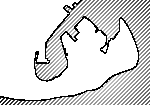The Salad Bowl.
Vol. IV, No. 10. Oct. 1996. (p. 1, 2)
 Shizuoka City Spotlights:
Shizuoka City Spotlights:
Miho Peninsula
The Miho Peninsula, with about 15 kilometers of shoreline, was formed from the build-up of alluvial sands from
the Abe River over millennia. Less than a kilometer wide at its base and three times that at midpoint, it is a place with many contrasts.
Until the early 1900s, the Miho Peninsula was actually an island. Miho-mura was a small fishing village which was absorbed by Shimizu City in
1926, and later by Shizuoka City in 2003. During its heyday in the 1960s, about *** people lived on the Miho
Peninsula, but today only about *** people live on there on its **** square kilometers of land.
The northeastern tip of this peninsula, known as Masaki, is its most scenic part. Although its coastline is often littered with trash,
the beaches here are popular for bathing in mid-summer and wind-surfing much of the year. A large public swimming pool operated by Tokai University is also located ten minutes from Masaki Beach.
Many visitors flock to Miho to see the Tokai University Aquarium
and Museums of Human Anatomy and Natural History. Those with a yen for miniaturization will enjoy Miho Bunka Land, which has
detailed replicas of many famous buildings within Japan and overseas.
The central and western parts of this peninsula are industrial. At one time there were extensive ship building facilities here. Those industries
have largely faded, and today one can see gutted rusting steel carcasses and broken concrete. The entire eastern side of this peninsula, however,
is designated as a conversation zone. There are over 45,000 pine trees, three parks, and more than a few hotels in this area. Despite the fact
that many of the beaches here are marked as sea-turtle breeding areas, motor vehicles have free access to the entire eastern coastline.
No turtles have been seen on this peninsula for more than five decades.
Miho-no-matsubara attracts more bus loads of tourists than
any other spot in Shizuoka. Unless you're shopping for trinkets, however, you may prefer to visit the nearby Miho Shrine. Located
near the center of the Miho peninsula, this shrine was constructed two millennia ago when Miho was yet an island. With its splendid monuments
and towering trees, only a part of this shrine belongs to the 20th Century. Festivals here are held each Nov. 1 and Feb. 15th.
What is most interesting about Miho was its contrasts: industrial, residential, agricultural, and conservation zones are in close proximity.
Although many of the structures here date from the economic heyday of the 1960's, evidence of Miho's earlier history still abounds.
- Tim Newfields
Copyright (c) 1996, 2003 by Tim Newfields & the Shizuoka City International Association
www.tnewfields.info/sb/miho.htm

 Shizuoka City Spotlights:
Shizuoka City Spotlights: